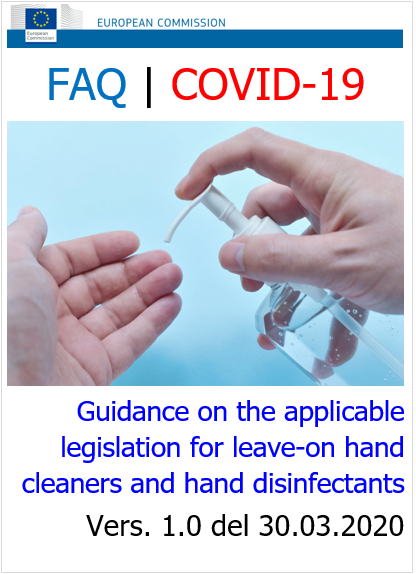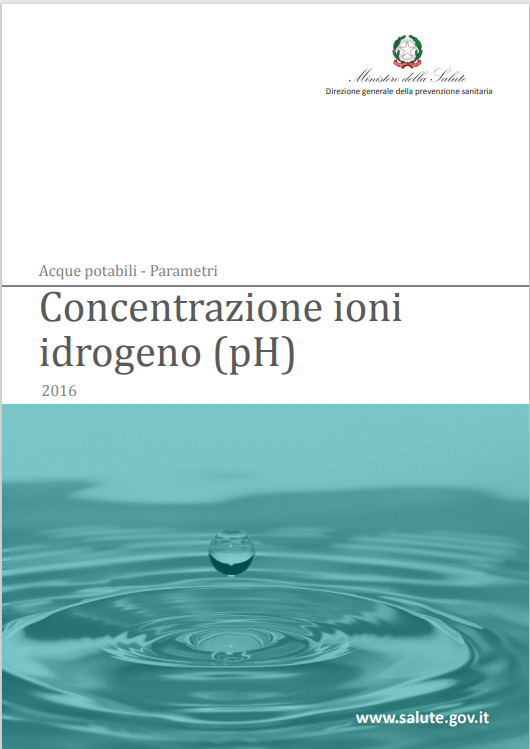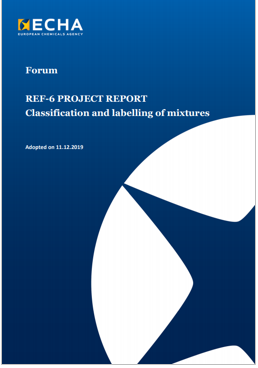Informazione tecnica HSE / 25 ° anno
/ Documenti disponibili:
45.653
/ Documenti scaricati: 34.692.032
/ Documenti scaricati: 34.692.032

Guidance on the applicable legislation for leave-on hand cleaners and hand disinfectants (gel, solution, etc.)
EU 30.03.2020
BACKGROUND
Following the spread of the Coronavirus (COVID-19) disease many actions have been carried out in EU to prevent and reduce the transmission of the virus. This includes enhanced hygiene practices. As preventive measure against the spread of Coronavirus (COVID-19) disease, the European Centre for Disease Prevention and Control recommends “Washing of hands with soap and water for at least 20 seconds, or cleaning hands with alcohol-based solutions, gels or tissues is recommended in all settings”.
The use of hand cleaners and hand disinfectants in forms of gels, hand wipes or other leave-on products has increased dramatically in the last weeks and this has resulted in general shortages across most EU countries. Several economic operators, mostly SMEs, are investing/considering to shift production chain and increase production of Hand cleaners and Hand disinfectants to respond to the additional needs in the context of the current Coronavirus crisis. In that sense, we have noticed a steep increase in the submission to the Cosmetics Product Notification Portal under the Cosmetics Regulation (Article 13) and related questions on the applicable legislation. In fact, according to several factors (e.g. claims, composition and purpose of use), hand cleaners and hand disinfectants are subject to different legal frameworks: Cosmetic Products Regulation or Biocidal Products Regulation.
Clear guidance for economic operators on the applicable legislation and related requirements is urgently needed. This guidance is based on existing practices and practical examples. In particular, while normally soap is a cosmetic product, other products such as alcohol-based solutions, gels, hand-cleaners, hand-disinfectants, etc. might require further clarification.
These products can be subject either to Cosmetic Products Regulation or Biocidal Products Regulation (normally only one legislation should be applicable to a product).
This depends first of all on the presence of an active substance and the main purpose of the product:
Products supplied with a main or exclusive cosmetic purpose (i.e. cleaning or cleansing the skin notably in absence of water rinsing) are covered by the Cosmetics Regulation.
Products containing an active substance and supplied with a primary biocidal purpose (i.e. intended to control harmful organisms) are not covered by the cosmetics legislation and therefore fall within the scope of the biocides legislation. Examples include products containing an active substance and making a claim to improve public health through the control of infectious organisms, such as “disinfecting”, “kill viruses”, “kill bacteria”, which would go beyond the general perception of personal hygiene and can include antibacterial hand gels.
Therefore:
- When their main purpose is to cleanse or clean the skin they are probably subject to the Cosmetic Products Regulation.
- If no main purpose is declared and such products contain an active substance and are marketed with any claims of biocidal activity or specific effects of reducing crosscontamination, they would be probably subject to the Biocidal Products Regulation.
Q2: What kind of claims would support a cosmetic purpose and classification for hand cleaners?
Although the claims themselves are not the only decisive factor whether the product should be considered as covered by the Cosmetics Regulation or the Biocidal Products Regulation, they are a relevant indication of the purpose of the product. “Physically clean / visually clean” and “Hand cleaner” are typical claims where the function is in line with the definition of a cosmetic product with respect to cleaning and improving the appearance of the hands or body. The product will have to comply with the Cosmetic Products Regulation.
However, if the product is presented with a claim stating “Hygienically clean” (or similar wording), the function ‘hygiene’ might indicate in this context that it could be considered as biocidal. The term hygiene has a broad spectrum of meaning which range from simple cleanliness to disinfection, depending on the context in which it is used. While in the context of cosmetics, the term normally refers to ‘personal hygiene’, i.e. products for cleaning and keeping in good condition the skin, in a context of biocidal products, the term ‘hygiene’ is associated with ‘disinfection’.
It is therefore important to look at all the characteristics of the product, and in particular its composition, the purpose and the function of the product. If it is clear that the product is mainly intended to protect public health through biocidal action (e.g. disinfecting, antimicrobial/virus function), which would go beyond the general perception of personal hygiene, and the objective criteria for considering such a product as “biocidal product” are fulfilled, the product cannot be considered as a cosmetic product and will have to comply with the Biocidal Products Regulation.
Q3: What kind of claims would preliminarily support a classification as biocidal product classification for hand-cleaners and hand-disinfectant?
The following list of examples is established solely on the basis of product claims. Claims may be a strong indication of the intended product purpose and will therefore help in forming a preliminary assumption on a product's regulatory status. However, it is important to assess all the characteristics of the product, including its composition, the purposes of its use and the mode of action on the harmful organism, on a case by case basis before making a final decision.
The following claims would preliminarily suggest that the product is a biocide covered by the Biocidal Products Regulation:
- “Antibacterial”
- “Unique antibacterial formulation.”
- “Kills bacteria”
- “Kill bacteria/a wide range of germs and words having the same meaning”
- “Antiviral” and words having the same meaning
- “Kills viruses, Virokill” and words having the same meaning
- “Effective against flu virus H1N1”
- “Effective against coronavirus”
In these examples, the product clearly makes a claim of general human hygiene through skin disinfection, and hence a claim to protect public health through biocidal action. In this case, the biocidal function is likely to be considered as the main function to which the cosmetic function has become secondary. In consequence, if the product contains an active substance and has the required function, the product would be excluded from the scope of the Cosmetics Products Regulation, and would need to comply with the Biocidal Products Regulation.
Q4: I am a company producing cosmetics, and I want to manufacture “hand disinfectants” to help in the context of an epidemic. What shall I do to be allowed to supply such “hand disinfectants” (on the market to the general public, to professionals, to medical care facilities etc.)?
The supply of “hand disinfectants” is subject to rules established under the Biocidal Products Regulation. You are advised to contact first the national competent authorities on biocidal products in the Member States where you intend to make such a supply. These authorities will be able to guide you on steps to follow, in particular to obtain an authorisation or an emergency permit if considered necessary by the Member States.
In particular:
- if your hand disinfectant would contain active substances still under examination in the “review programme” set out in Regulation (EU) No 1062/2014 (see Annex II), your hand disinfectant would have to be placed on the market in the Member States subject to compliance with the national rules, and possible derogation therefrom.
- If your hand disinfectant would contain active substances which have been assessed and approved under the Biocidal Products Regulation, the Member States would normally need to grant an authorisation in accordance with the Regulation. Member States can also grant you an emergency permit under Article 55(1) if they consider it necessary to allow your product on the market especially in the context of the current Covid-19 crisis.
...
Fonte: EU
Collegati:

ID 18813 | 26.01.2023 / In allegato
Il pH di una soluzione è il logaritmo negativo in base 10 dell’attività degli ioni idrogeno...

ECHA, 17 dicembre 2019
Il sesto progetto del Forum di applicazione a livello UE (REF-6) si è concentrato sulla classificazione...

Regolamento (UE) 2015/830 della Commissione del 28 m...
Testata editoriale iscritta al n. 22/2024 del registro periodici della cancelleria del Tribunale di Perugia in data 19.11.2024